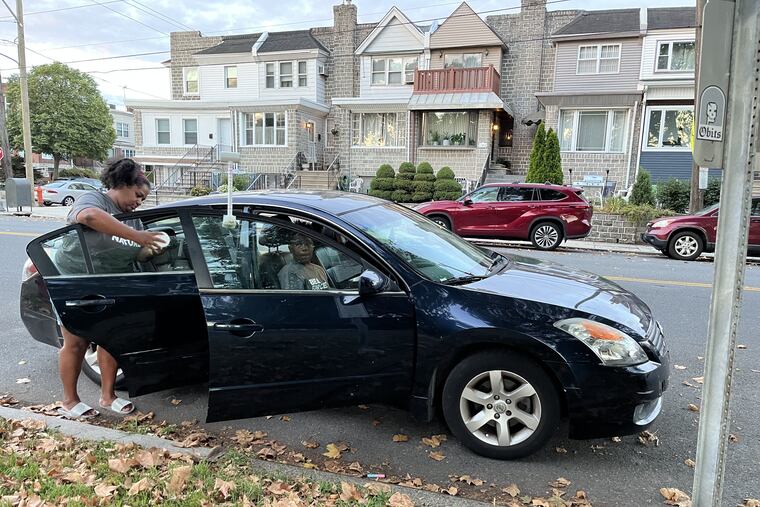50 Philly residents are blitzing the city Saturday, gadgets jutting from cars, to record heat and pollution
Philly was one of 16 communities in the U.S. and abroad chosen to measure the effects as part of a study overseen by the federal Oceanic and Atmospheric Administration.

Meeka Outlaw mounted a temperature sensor to the front passenger-side window of her navy blue Nissan Altima just before daybreak Saturday, then attached an air-pollution sensor to the rear passenger side, waiting for it to blink green and let her know the mission was a go.
Concerned that the air-pollution monitor didn’t seem to be blinking — a signal that the GPS was working — she waited a few more minutes until it finally went live. Relieved, Outlaw climbed into the driver’s seat, her son, Rashid, 12, next to her, and started to drive a carefully laid-out 13-mile route through South Philadelphia, starting at Marconi Plaza.
Rashid was still sleepy, but started to rouse and witness his first sunrise in the city.
The duo were part of a one-day, citywide effort to measure heat and pollution in urban heat islands — areas with little shade and lots of concrete and asphalt can spike 15 to 20 degrees warmer than surrounding areas. They were among 50 volunteers who drove 10 routes with specially equipped cars covering most of the city as part of a study overseen by the federal Oceanic and Atmospheric Administration.
Philly was one of 16 communities in the United States and abroad chosen to measure the effects, but only one of a few cities recording pollution.
“I hope this helps to show the city of Philadelphia that there is a need for more green space to help their environment, and that not every single lot in the city needs to have a house or building on it,” said Outlaw, founder of the Grays Ferry-based Residents Organized for Advocacy and Direction (ROAD). “In Grays Ferry, green spaces are few and far between. Trees and parks are important for gardening, bees, and just to have space for peace of mind.”
Each vehicle like Outlaw’s was to cruise through the city in three one-hour shifts starting at 6 a.m., 3 p.m., and 7 p.m., according to organizer Richard Johnson, director of community science at the Academy of Natural Sciences of Drexel University. The volunteers planned to cover about 100 square miles, or more than 70% of Philly’s 140 square miles.
What will the study show?
Johnson said the study will show the areas of the city suffering the most from heat and pollution. Extreme heat kills more people than any other weather event, according to federal authorities, who say climate change is exacerbating the issue. In the most recent heat wave that ended Tuesday, at least five deaths were reported in Philadelphia.
Heat can also exacerbate the effects of pollution. Often, the worst areas are in communities of color, or of lower income.
“I hope it creates a lot more awareness for the issues because we involved the community in the process of gathering all the information,” Johnson said. “It will allow the city to make more informed decisions about equitable solutions for heat and air quality.”
The study is part of an effort by the National Integrated Heat Health Information System (NIHHIS), in partnership with CAPA Strategies. The NIHHIS is a campaign by NOAA. And CAPA is a private company that receives federal funding to capture and analyze data, as well as build digital tools used for crafting local resiliency plans.
The study has been carried out in other cities since 2017. Other communities taking part this summer: Boulder, Colo.; Clark County, Nev. (which includes Las Vegas); Columbia, S.C.; Columbus, Ohio; Jacksonville, Fla.; Knoxville and Nashville, Tenn.; Milwaukee; Montgomery County, Md.; Omaha, Neb.; Spokane, Wash.; Brooklyn, N.Y.; and San Francisco, as well as Freetown, Sierra Leone, and Rio de Janeiro, Brazil.
The air quality sensors recorded PM2.5, or fine particulate matter. PM2.5, defined as concentrations of 2.5 microns or smaller, is of special concern. The particles are smaller than the width of a human hair and easily inhalable. They are responsible for the biggest proportion of health effects from air pollution.
The biggest sources of PM2.5 outdoors are from motor vehicle exhaust, construction equipment, power plants, and operations that burn wood, oil, or coal. Particles form when emissions react in the air. Health effects can stem from short or long exposure and can range from aggravation of asthma and other respiratory illnesses to premature death in people with chronic heart or lung diseases. Children and seniors are most vulnerable.
For the data to be meaningful, NOAA gave instructions that the collection had to be conducted on a day 90 degrees or warmer, with very little wind, and clear skies. Saturday proved nearly perfect with a forecast high of 90, a slight breeze, and lots of sun.
“The sensors are collecting a measurement like every second,” Johnson said. “They’ll take all of those thousands and thousands of points of information and compile it into a detailed heat and air quality map for the city that will come out in the fall.”
In Philly, Johnson worked in partnership with Philadelphia Parks and Recreation, the Pennsylvania Horticultural Society, Temple University professor Christina Rosan, and Russell Zerbo from the Clean Air Council.
As she drove, Outlaw, a teacher at St. Francis Cabrini Catholic School, dressed in a “Be a Force of Nature” T-shirt supplied for the trek, squinted into the rising sun as Rashid flipped through the pages of directions. Together, they piloted the car through dozens of streets such as Tasker and Packer, Passyunk, and Snyder Avenues, as well as Columbus Boulevard.
“Right or left on 20th?” Outlaw asked her son, the navigator, one of multiple times they had to stop and navigate their path.
“I think,” Outlaw said, “that in areas where there is more green space it’s not as hot, and it’s not as polluted.”